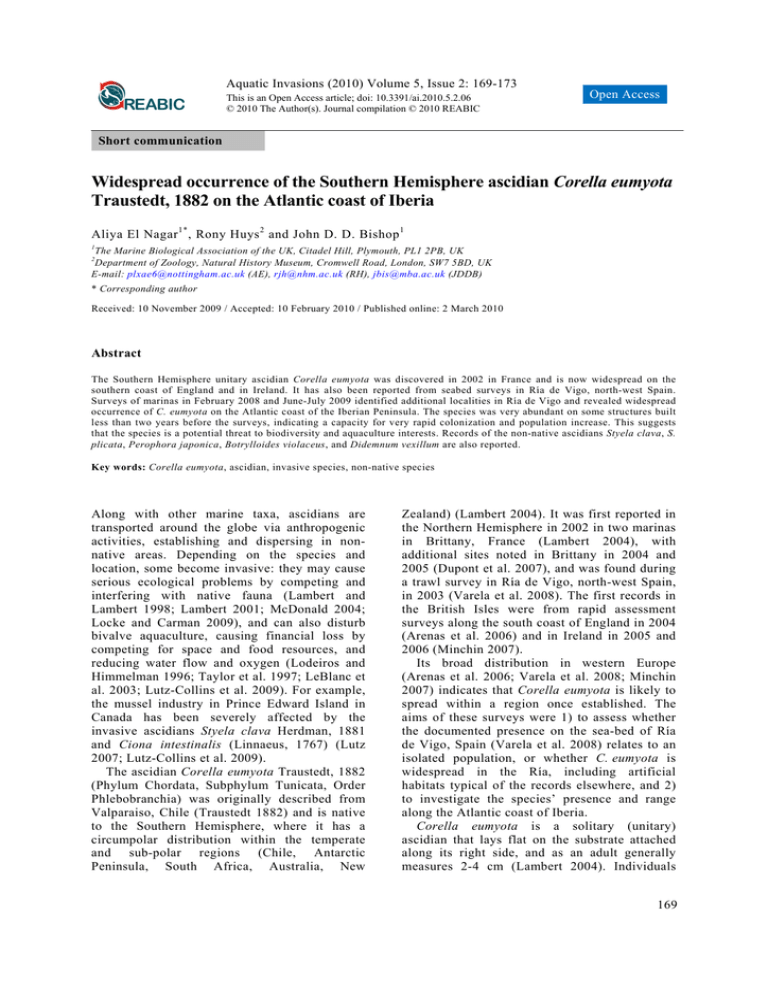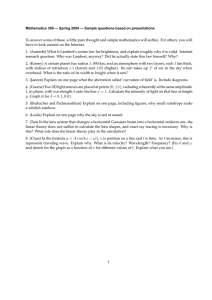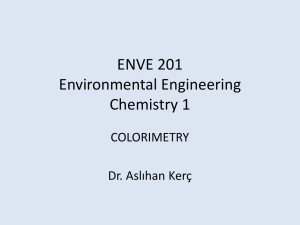Aquatic Invasions (2010) Volume 5, Issue 2: 169-173 Open Access
advertisement

Aquatic Invasions (2010) Volume 5, Issue 2: 169-173 This is an Open Access article; doi: 10.3391/ai.2010.5.2.06 © 2010 The Author(s). Journal compilation © 2010 REABIC Open Access Short communication Widespread occurrence of the Southern Hemisphere ascidian Corella eumyota Traustedt, 1882 on the Atlantic coast of Iberia Aliya El Nagar 1* , Rony Huys 2 and John D. D. Bishop 1 1 The Marine Biological Association of the UK, Citadel Hill, Plymouth, PL1 2PB, UK Department of Zoology, Natural History Museum, Cromwell Road, London, SW7 5BD, UK E-mail: plxae6@nottingham.ac.uk (AE), rjh@nhm.ac.uk (RH), jbis@mba.ac.uk (JDDB) 2 * Corresponding author Received: 10 November 2009 / Accepted: 10 February 2010 / Published online: 2 March 2010 Abstract The Southern Hemisphere unitary ascidian Corella eumyota was discovered in 2002 in France and is now widespread on the southern coast of England and in Ireland. It has also been reported from seabed surveys in Ría de Vigo, north-west Spain. Surveys of marinas in February 2008 and June-July 2009 identified additional localities in Ría de Vigo and revealed widespread occurrence of C. eumyota on the Atlantic coast of the Iberian Peninsula. The species was very abundant on some structures built less than two years before the surveys, indicating a capacity for very rapid colonization and population increase. This suggests that the species is a potential threat to biodiversity and aquaculture interests. Records of the non-native ascidians Styela clava, S. plicata, Perophora japonica, Botrylloides violaceus, and Didemnum vexillum are also reported. Key words: Corella eumyota, ascidian, invasive species, non-native species Along with other marine taxa, ascidians are transported around the globe via anthropogenic activities, establishing and dispersing in nonnative areas. Depending on the species and location, some become invasive: they may cause serious ecological problems by competing and interfering with native fauna (Lambert and Lambert 1998; Lambert 2001; McDonald 2004; Locke and Carman 2009), and can also disturb bivalve aquaculture, causing financial loss by competing for space and food resources, and reducing water flow and oxygen (Lodeiros and Himmelman 1996; Taylor et al. 1997; LeBlanc et al. 2003; Lutz-Collins et al. 2009). For example, the mussel industry in Prince Edward Island in Canada has been severely affected by the invasive ascidians Styela clava Herdman, 1881 and Ciona intestinalis (Linnaeus, 1767) (Lutz 2007; Lutz-Collins et al. 2009). The ascidian Corella eumyota Traustedt, 1882 (Phylum Chordata, Subphylum Tunicata, Order Phlebobranchia) was originally described from Valparaiso, Chile (Traustedt 1882) and is native to the Southern Hemisphere, where it has a circumpolar distribution within the temperate and sub-polar regions (Chile, Antarctic Peninsula, South Africa, Australia, New Zealand) (Lambert 2004). It was first reported in the Northern Hemisphere in 2002 in two marinas in Brittany, France (Lambert 2004), with additional sites noted in Brittany in 2004 and 2005 (Dupont et al. 2007), and was found during a trawl survey in Ría de Vigo, north-west Spain, in 2003 (Varela et al. 2008). The first records in the British Isles were from rapid assessment surveys along the south coast of England in 2004 (Arenas et al. 2006) and in Ireland in 2005 and 2006 (Minchin 2007). Its broad distribution in western Europe (Arenas et al. 2006; Varela et al. 2008; Minchin 2007) indicates that Corella eumyota is likely to spread within a region once established. The aims of these surveys were 1) to assess whether the documented presence on the sea-bed of Ría de Vigo, Spain (Varela et al. 2008) relates to an isolated population, or whether C. eumyota is widespread in the Ría, including artificial habitats typical of the records elsewhere, and 2) to investigate the species’ presence and range along the Atlantic coast of Iberia. Corella eumyota is a solitary (unitary) ascidian that lays flat on the substrate attached along its right side, and as an adult generally measures 2-4 cm (Lambert 2004). Individuals 169 A. El Nagar et al. have been found in the Northern Hemisphere measuring up to 8 cm (authors’ pers obs), and the species may attain considerably larger size in the Southern Hemisphere (e.g. an Antarctic or Subantarctic specimen 15cm long noted by Kott 1969). The coloration and shape of C. eumyota can vary significantly (Figure 1). In the nonnative range it can be transparent, white, brown, or various shades of orange; its siphons are usually orange, although not always. The tunic is smooth and often clean, but can be covered in microbial film or overgrown by other species, including compound ascidians. The shape of the body can mould into the available space between the adjoining sessile fauna, however on open substrate it will grow into an oval shape. The inhalant siphon is normally at the extreme end of the body and the exhalant siphon is characteristically between a quarter and half-way down the body, and slightly on the right. The direction in which the siphons point, and their length, vary. As described by Lambert (2004), C. eumyota cannot retract its siphons. The hind-gut forms a simple curve following the contour of the posterior end of the body (Kott 1969). The oviduct and sperm duct are unusually short, opening on the surface of the gonad at the posterior end of the body, and the embryos are brooded far from the exhalant siphon (Lambert 2004). We suggest the English vernacular name “Orange-tipped Sea-squirt” for this species, referring to the common orange coloration of the siphons. We visited coastal marinas where Corella eumyota might be found on suitable substrates that could be accessed from pontoons, which included the submerged surfaces of the pontoons themselves, sea-walls at low tide, and any submerged objects. The biofouling communities on underwater surfaces were inspected, if necessary with the aid of a long-handled scraper and net to obtain samples. Objects such as tyres, submerged ropes, nets, and cages were pulled out for examination. Large clumps of mussels were pulled apart to search for individuals growing inside. When C. eumyota was found, we continued to search, and collected it across the marina for intended phylogeographic studies. See Table 1 for a list of the localities surveyed (sites visited that did not harbour marine life due to heavy freshwater influence were not included in this study). Corella eumyota was widespread on the Atlantic coast between Gijón (N Spain) and Oeiras (Portugal) (Figure 2). It was present in 17 of the 22 coastal marinas surveyed during the 170 three surveys (February 2008, June and July 2009), including all of those in Ría de Vigo (Table 1). The pontoons at Muros had recently been cleaned of biofouling, and did not provide suitable submerged objects, hence its presence or absence prior to the removal of the biofouling communities remains unknown. The main target of these surveys was Corella eumyota, but some other non-native ascidians were encountered. Two nearby colonies of Perophora japonica Oka, 1927 were discovered in Baiona. This colonial ascidian was not seen anywhere else throughout the surveys and this is the first known record from Iberia (and southern Europe). The invasive species Didemnum vexillum Kott, 2002, which is possibly native to the northwestern Pacific Ocean (Stefaniak et al. 2009), was sighted in Santander (marina deportiva), Baiona, Moaña, Corme-Porto, and Gijón. Botrylloides violaceus Oka, 1927 was seen in Bueu, Nazaré, and Santander. Styela clava Herdman, 1881 was encountered (two specimens only) at Sines, a slight range extension from the previous southern limit of Cascais and Lisboa (Davis and Davis 2005). Styela plicata (Lesueur, 1823) was seen at Nazaré, Peniche and Albufeira. In Ría de Vigo Corella eumyota is widespread and was found in all sufficiently marine sites visited (judged from the other fauna present). This non-native ascidian was very abundant in Cangas and Moaña, two marinas that are in close proximity to mussel farms in the area. The Porto Deportivo de Moaña had been built approximately two years before the visit. Despite its age, the submerged sides of the pontoon harboured large numbers of mussels and Corella eumyota, diverse sessile fauna, and associated motile macrofauna. The ready settlement of C. eumyota on, around, and inside clumps of mussels and its presence in the proximity of mussel farms suggest that this ascidian might have been transported to the Northern Hemisphere via the mussel farming trade, one of the possibilities listed by Lambert (2004). Transport to major ports by hull fouling in sea chests, with subsequent local spreading by fouling of small boats and/or aquaculture transfers, is also possible (Wasson et al. 2001; Lambert 2009). Corella eumyota is now widespread along the Atlantic coastline of Iberia. Its abundance in the marinas ranged between rare and highly abundant. At the sites where other solitary ascidians including Ciona intestinalis and Ascidiella aspersa (O.F. Müller 1776) were rare, Iberian records of Corella eumyota Figure 1. Photographs of some morphological varieties of Corella eumyota. The top right image shows the species, here with orange-tipped siphons, dominating the submerged surface of a concrete pontoon (Vila Praia de Âncora, Portugal 2008). Photographs by A. El Nagar. Figure 2. Map with localities of surveyed marinas. Red dots are where Corella eumyota was recorded, while green are marinas where the species was not found. (The base maps were generated on http://www.planiglobe.com). C. eumyota was usually more numerous. For example, in Oeiras this non-native was common, and the typical native marina inhabitant ascidian Ascidiella aspersa was not found. Such apparent changes in community structure suggest that C. eumyota may be capable of out-competing species with similar habitats, but this needs further observation or experimentation for confirmation. The abundance of C. eumyota appeared to have a negative correlation with that of the non-native red bryozoan Watersipora sp., being rarer when the bryozoan was abundant. There may also be a seasonal trend in abundance: C. eumyota was generally more common at sites visited in February than in June and July. This might be explained by its being a 171 A. El Nagar et al. Table 1. Localities surveyed in Spain and Portugal. Abundance of Corella eumyota is reported as an approximate estimate where absent = 0, present = 1-30, frequent = 31-60, and abundant = >60 individuals per square metre of suitable substrate. Location Description of Marina Geographic coordinates Latitude Longitude Abundance Date/s visited Spain Vigo (Esquela de Velo Marina) Puerto de Cangas Porto Deportivo Moaña Chapela Baiona Real Club Maritimo, Santander Marina deportiva de Santander, Santander Puerto Deportivo de Gijón Puerto de Burela Puerto de Cudillero Puerto de Muros Puerto de Corme-Porto A Coruña Bueu Recreational Recreational Recreational Recreational/fishing Recreational/fishing Recreational Recreational Recreational Fishing Recreational Recreational Recreational/fishing Recreational Fishing 42.227 42.260 42.277 42.268 42.121 43.462 43.428 43.545 43.660 43.567 42.776 43.262 43.369 42.328 -8.751 -8.783 -8.735 -8.676 -8.847 -3.794 -3.808 -5.665 -7.355 -6.149 -9.058 -8.965 -8.397 -8.786 Present Abundant Abundant Frequent Frequent Absent Absent Frequent Present Absent Absent Frequent Frequent Present 04.02.2008 06.02.2008 06.02.2008 07.02.2008 08.02.2008 13.06.2009 13.06.2009 13.06.2009 14.06.2009 14.06.2009 15.06.2009 15.06.2009 16.06.2009 18.07.2009 Póvoa de Varzim Vila Praia de Âncora Recreational Fishing 41.370 41.815 -8.765 -8.869 Abundant Abundant Puerto de Matosinhos Recreational/near port 41.186 -8.705 Present Peniche Nazaré Oeiras Sines Albufeira Recreational Recreational Recreational Recreational Recreational 39.352 39.584 38.676 37.950 37.084 -9.377 -9.075 -9.318 -8.866 -8.267 Frequent Present Frequent Absent Absent 09.02.2008 09.02.2008/ 17.07.2009 10.02.2008/ 10.07.2009 14.07.2009 14.07.2009 15.07.2009 16.07.2009 16.07.2009 Portugal cool-temperate and sub-polar species, so perhaps it does not tolerate well the warmer summer surface temperatures though it may find deeper water refuges from which it can repopulate marina surfaces; such a phenomenon occurs every year in comparable species in southern California (Lambert and Lambert 1998, 2003). C. eumyota was highly abundant in two recently-built marinas, the aforementioned Porto Deportivo de Moaña (Spain), and the pontoon in the fishing marina of Vila Praia de Âncora (Portugal). Both had been built two-three years previous to the surveys (pers comm; harbour master and local resident, respectively), showing that C. eumyota has the capacity to establish dense populations very rapidly. Its occurrence in Vila Praia de Âncora, Portugal in 2008 was particularly alarming: C. eumyota on the submerged surface of the pontoon was by far the dominant sessile species and formed an almost continuous carpet (see Figure 1). When this site was revisited in July 2009, C. eumyota remained the most abundant species, but other sessile 172 fauna, including mussels, other ascidians, and large kelps were also present in substantial numbers. Observations at Moaña and Vila Praia de Âncora suggest that C. eumyota can be an early and rapid colonizer that continues to compete successfully for resources, but it may not actually prevent other sessile species from colonizing. Ascidians are known to compete for resources, and to reduce water flow (Lodeiros and Himmelman 1996; Taylor et al. 1997; LeBlanc et al. 2003; Lutz-Collins et al. 2009). Lambert (2004) described C. eumyota’s habit of forming tight clumps by settling on conspecifics, and predicted that it may become a problem in mussel and oyster farms in its introduced range. C. eumyota has been found in association with mussels (and occasionally scallops) on this survey, and will possibly affect European bivalve aquaculture in the future. Additionally, this non-native was collected from the seabed in Ría de Vigo in 2003 (Varela et al. 2008), and is therefore capable of invading natural habitats, Iberian records of Corella eumyota which may have serious consequences for coastal ecosystems. Given that Corella eumyota is certainly spreading rapidly around W Europe, both in artificial and natural habitats, and is often abundant, it is becoming a significant invasive species in Europe. Acknowledgements We would like to thank all the harbour masters and marina staff for the permission to survey and for their help at the marinas. This work was funded by the Esmée Fairbairn Foundation, the Axa Research Fund, and the Oceans 2025 Strategic Research Programme of the UK Natural Environment Research Council (NERC). We thank two anonymous referees for comments that improved the manuscript. References Arenas F, Bishop JDD, Carlton JT, Dyrynda PJ, Farnham WF, Gonzalez DJ, Jacobs MW, Lambert C, Lambert G, Nielsen SE, Pederson JA, Porter JS, Ward S, Wood CA (2006) Alien species and other notable records from a rapid assessment survey of marinas on the south coast of England. Journal of the Marine Biological Association of the United Kingdom 86: 1329-1337, doi:10.1017/ S0025315406014354 Davis MH, Davis ME (2005) Styela clava (Tunicata, Ascidiacea) - a new addition to the fauna of the Portuguese coast. Journal of the Marine Biological Association of the United Kingdom 85: 403-404, doi:10.1017/S002531540501132Xh Dupont L, Viard F, David P, Bishop JDD (2007) Combined effects of bottlenecks and selfing in populations of Corella eumyota, a recently introduced sea squirt in the English Channel. Diversity and Distributions 13: 808817, doi:10.1111/j.1472-4642.2007.00405.x Kott P (1969) Antarctic Ascidiacea. Antarctic Research Series 13: i–xv and 1-239 Lambert CC, Lambert G (1998) Non-indigenous ascidians in southern California harbors and marinas. Marine Biology 130: 675-688, doi:10.1007/s002270050289 Lambert G (2001) A global overview of ascidian introductions and their possible impact on endemic fauna. In: Sawada H, Yokosawa H, Lambert C (eds) The Biology of Ascidians, Springer-Verlag, Tokyo, pp 267-269 Lambert CC, Lambert G (2003) Persistence and differential distribution of nonindigenous ascidians in harbors of the Southern California Bight. Marine Ecology Progress Series 259: 145-161, doi:10.3354/meps259145 Lambert G (2004) The south temperate and Antarctic ascidian Corella eumyota reported in two harbours in northwestern France. Journal of the Marine Biological Association of the United Kingdom 84: 239-241, doi:10.1017/S0025315404009105h Lambert G (2009) Adventures of a sea squirt sleuth: unraveling the identity of Didemnum vexillum, a global ascidian invader. Aquatic Invasions 4: 5-28, doi:10.3391/ ai.2009.4.1.2 LeBlanc AR, Landry T, Miron G (2003) Fouling organisms of the blue mussel Mytilus edulis: their effect on nutrient uptake and release. Journal of Shellfish Research 22: 633-658 Locke A, Carman M (2009) An overview of the 2nd International Invasive Sea Squirt Conference: What we learned. Aquatic Invasions 4: 1-4, doi:10.3391/ai.2009. 4.1.1 Lodeiros CJM, Himmelman JH (1996) Influence of fouling on the growth and survival of the tropical scallop, Euvola (Pecten) ziczac (L.1758) in suspended culture. Aquaculture Research 27: 749-756, doi:10.1046/j.13652109.1996.t01-1-00790.x Lutz V (2007) Epifaunal communities associated with mussel socks in an estuarine system of Eastern Prince Edward Island: influence of mussel stocking density, season of deployment, and location. Honors Thesis, University of Prince Edward Island, Charlottetown, Canada, pp 8-28 Lutz-Collins V, Ramsay A, Quijón PA, Davidson J (2009) Invasive tunicates fouling mussel lines: evidence of their impact on native tunicates and other epifaunal invertebrates. Aquatic invasions 4: 213-220, doi:10.3391/ ai.2009.4.1.22 McDonald J (2004) The invasive pest species Ciona intestinalis (Linnaeus, 1767) reported in a harbour in southern Western Australia. Marine Pollution Bulletin 49: 868-870, doi:10.1016/j.marpolbul.2004.08.024 Minchin D (2007) Rapid coastal survey for targeted alien species associated with floating pontoons in Ireland. Aquatic Invasions 2: 63-70, doi:10.3391/ai.2007.2.1.8 Stefaniak L, Lambert G, Gittenberger A, Zhang H, Lin S, Whitlatch RB (2009) Genetic conspecificity of the worldwide populations of Didemnum vexillum Kott, 2002. Aquatic Invasions 4: 29-44, doi:10.3391/ ai.2009.4.1.3 Taylor JJ, Southgate PC, Rose RA (1997) Fouling animals and their effect on the growth of the silver-lip oysters, Pinctada maxima (Jameson), in suspended culture. Aquaculture 153: 31-40, doi:10.1016/S0044-8486(97)000 14-8 Traustedt MPA (1882) Vestindiske Ascidiae simplices. I. Phallusiidae. Videnskabelige Meddelelser fra dansk naturhistorisk Forening i Kjøbenhavn 1881: 257-288 Varela MM, de Matos-Pita SS, Ramil F, Ramos-Esplá AA (2008) New report of the Antarctic ascidian Corella eumyota (Tunicata: Ascidiacea) on the Galician coast (north-west Spain). Marine Biodiversity Records 1: e59, doi:10.1017/S1755267207006574 Wasson K, Zabinc CJ, Bedinger L, Diaz MC, Pearse JS (2001) Biological invasions of estuaries without international shipping: the importance of intraregional transport. Biological Conservation 102: 143-153, doi:10.1016/S0006-3207(01)00098-2 173





